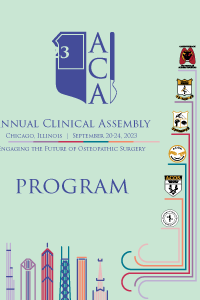ACOS 2023 Annual Clinical Assembly
Cardiothoracic Surgery
General Vascular Surgery
Novel Interactome Networks Of Noncoding RNAs in Human Cardiomyopathic Heart Failure

Hayden K. Roberts (he/him/his)
Osteopathic Medical Student
New York Institute of Technology College of Osteopathic MedicineDisclosure(s): No financial relationships to disclose
Member Speaker(s)
Learning Objectives:
- Design research studies to explore biological processes in cardiothoracic surgical settings
- Identify novel mechanisms involved in cardiomyopathic heart failure
- Compare and contrast the roles of novel noncoding RNAs in ischemic versus nonischemic cardiomyopathy
Noncoding ribonucleic acids are RNA molecules that do not code for proteins and include long noncoding (lnc)RNAs ( >200 nucleotides) and micro(mi)RNAs (21-23 nucleotides). The noncoding regions span ~98% of the human genome and the majority (80-90%) of them are considered to be functionally important. Furthermore, the majority (~93%) of disease- and trait-associated variants emerging from Genome-Wide Association Studies were reported to lie within the noncoding regions. Studies have shown key pathophysiological roles of noncoding RNAs in coronary artery disease, hypertrophy, hypertension, cardiac remodeling and development, etc. However, the roles and interactions of noncoding RNAs with mRNAs in human ischemic (ICM) and nonischemic cardiomyopathic (NICM) heart failure (HF) are unclear. Identifying novel genes and interactions may help uncover potential biomarkers and therapeutic targets and facilitate improved outcomes in terminal HF. In this Institutional review boards-approved study, we began analyzing clinical data from patients undergoing heart transplantation or left ventricular (LV) Assist Device implant procedures following ischemic (n = 11) or non-ischemic (n = 10) cardiomyopathic HF. Organ donors who died due to non-cardiac causes served as controls (n = 7). Statistical analyses of patients with an age of 53±11 years (males and females) were performed using Tukey’s analysis of variance and post-hoc analyses. Compared to organ donor controls, both ICM (EF: 17.5% ± 3.5) and NICM (EF:20.6% ± 3.2) groups displayed significantly decreased ejection fraction (EF: p< 1E-10). The LV internal diameter was increased (diastole and systole; p< 0.01). While the QTc interval and QRS duration were prolonged in NICM (p < 0.05), the LV end-systolic volume was increased in ICM. We subsequently isolated total RNA from LV tissues carefully obtained from all three groups (n = 4 per group). They underwent Novogene library preparation and transcriptomic sequencing followed by extensive bioinformatic analyses for noncoding and coding RNAs. Both the samples and the data were validated using elaborate quality control protocols. The studies were performed in a blinded fashion. Our studies uncovered differential expression of numerous lncRNAs, miRNAs, and messenger (m) RNAs (p-corrected/adjusted; padj < 0.05). The transcriptomic approach revealed 251 novel lncRNAs, 137 novel mature miRNAs, and 286 novel mRNAs (padj < 0.05). Several lncRNA alternative splicing events (padj < 0.001; false discovery rate < 0.05), numerous silent and missense mutations, and minimal nonsense mutations were also observed. Both ICM and NICM groups (padj < 0.05) displayed unique characteristics in their enrichment pathways. Gene Ontology (GO), Kyoto Encyclopedia of Genes and Genomes (KEGG), Reactome and Disease Ontology enrichment analyses detected multiple pathways involved in thyroid, neuroembryological development, neuro/macular degeneration, cancer, inflammation, bone remodeling, vein disease, etc. Highly significant lncRNA-mRNA interactions were revealed by co-expression analysis with Pearson Correlation Coefficient of < 0.95 and >0.95 (p < 0.00001). Of interest, we observed numerous miRNA-mRNA interactions related to pathways including bacterial/viral, parathyroid, autophagy cancer, etc. by GO/KEGG (padj < 0.05). In ICM, seven lncRNA-associated protein-protein interaction networks were identified with >700 confidence score. Furthermore, our findings also differentiated between ICM and NICM (padj < 0.05) among several genes and interactions in all the aforesaid RNA species and multiple enrichment pathways. This study provides a novel transcriptomic and interactomic understanding of HF secondary to ICM and NICM. Future studies aimed at dissecting the pathophysiological significance of noncoding RNAs both individually and in partnership with other RNAs and proteins will be required. These will pave the way for the discovery of potential new biomarkers and therapeutic targets for attenuating or delaying the impact of terminal HF. They may also help in further improving the timing and strategy for surgical interventions such as ventricular assist devices and cardiac transplantation.
Methods or Case Description:
Outcomes:
Conclusion:

